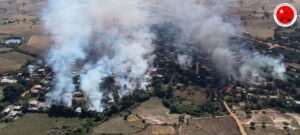
SHAN STATE – The water level is rising in Inle Lake, with all one-storied houses now under water and a total of 171 villages are affected by the flood, said Ms. Phoo Phoo, a social worker doing flood rescue works in Inle Region.
Water started flowing into Inle Lake on September 9, increasing the water level and as of September 15, all one-storied houses in the lake are said to have sunk under water and the residents of the villages are sheltering at the monasteries and multi-storied buildings. Moreover, mobile network and internet network are said to be out of service and there is also no electricity.
“The flooding in Inle Lake did not happen suddenly. The water from the upper region flowed into the lake and the water level rose gradually so the people had time to move. Now, all one-storied houses in the lake are under water. The people are sheltering in monasteries and two-storied buildings. If you wish to help the flood victims in Inle, they don’t need clothes but the few grocery shops are under water so they mainly need food, medicine and torches and batteries for light. Medicine is needed. The water level is extremely high so it might take months for it to recede,” said Ms. Phoo Phoo.
Phaungtawoo Pagoda and Nanpan Market are also said to have sunken under water and it is reported that 171 villages in Thalay Village Tract, Ywama Village Tract, Thapyaypin Village Tract, Taungbhoni Village Tract, Kaylar Village Tract, Nanpan Village Tract, Maitauk Village Tract, Naungtaw Village Tract, Ywagyi Village Tract and Innpawkhon Village Tract are affected by the flood and need assistance.
“In the villages on land, even two-storied houses are about to be under water level. It is worse for the villages in the lake. If you wish to help Inle, please focus on more food and ration. Because of the flood, many properties were lost,” added Ms. Phoo Phoo.
The people affected by the flood in Inle Lake are having difficulties with their meals and general living as well as transportation and there are also healthcare risks due to the shortage of electricity, mobile networks and internet networks.



